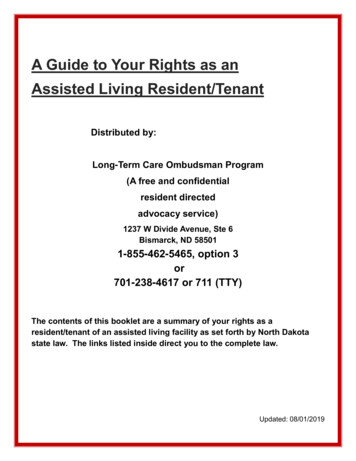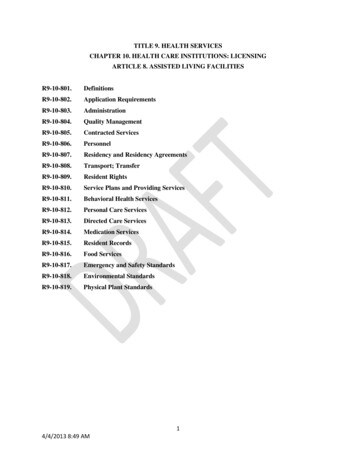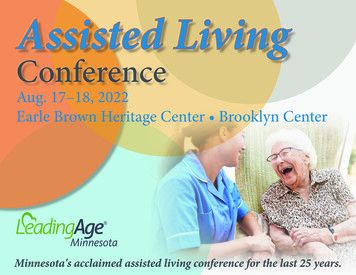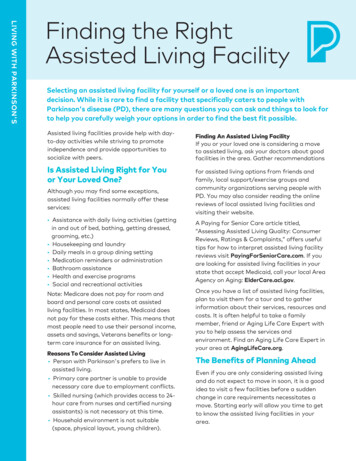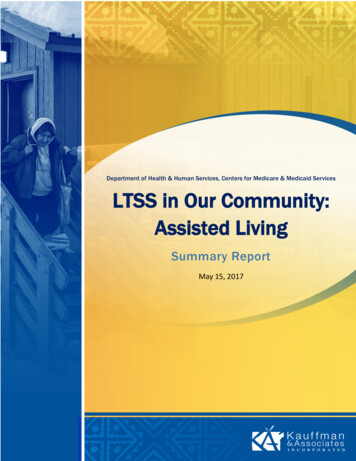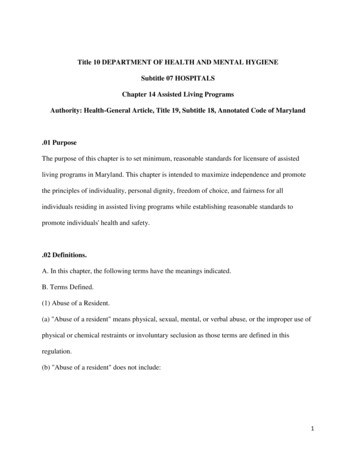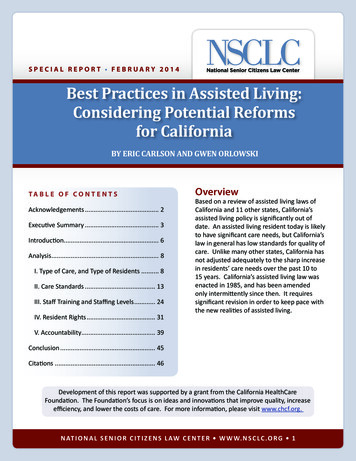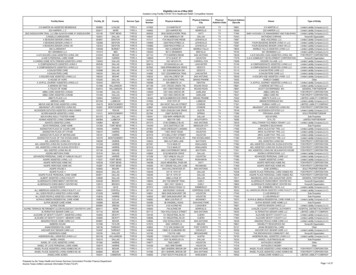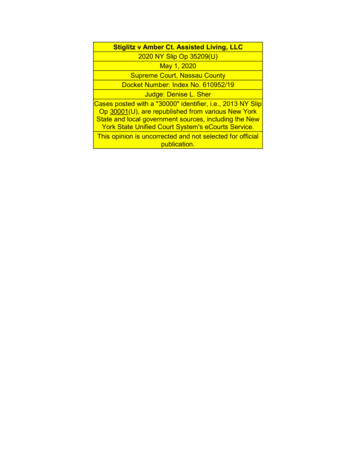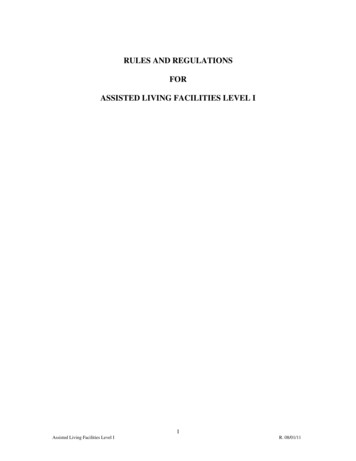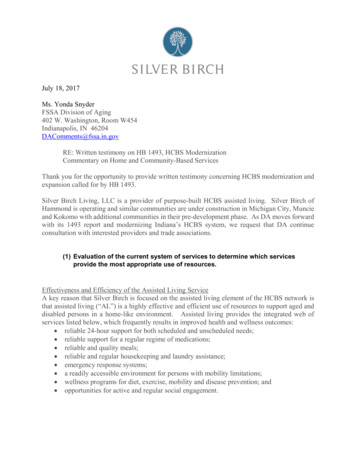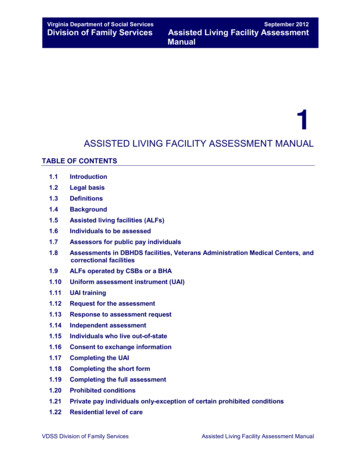
Transcription
Virginia Department of Social ServicesDivision of Family ServicesSeptember 2012Assisted Living Facility AssessmentManual1ASSISTED LIVING FACILITY ASSESSMENT MANUALTABLE OF CONTENTS1.1Introduction1.2Legal basis1.3Definitions1.4Background1.5Assisted living facilities (ALFs)1.6Individuals to be assessed1.7Assessors for public pay individuals1.8Assessments in DBHDS facilities, Veterans Administration Medical Centers, andcorrectional facilities1.9ALFs operated by CSBs or a BHA1.10Uniform assessment instrument (UAI)1.11UAI training1.12Request for the assessment1.13Response to assessment request1.14Independent assessment1.15Individuals who live out-of-state1.16Consent to exchange information1.17Completing the UAI1.18Completing the short form1.19Completing the full assessment1.20Prohibited conditions1.21Private pay individuals only-exception of certain prohibited conditions1.22Residential level of careVDSS Division of Family ServicesAssisted Living Facility Assessment Manual
Virginia Department of Social ServicesDivision of Family ServicesSeptember 2012Assisted Living Facility AssessmentManual1.23Assisted living level of care1.24Independent living1.25Psychosocial assessments1.26Referral for mental health (MH), intellectual disability (ID), or substance abuseevaluation1.271.281.26.1Referral for MH evaluation1.26.2Referral for ID evaluation1.26.3Referral for substance abuse evaluationLicensing requirements for screening of psycosocial, behavioral and emotionalfunctioning prior to admission1.27.1Mental health screening1.27.2Psychosocial and behavioral history1.27.3Mental health screening determination formAdmission of individuals with serious cognitive impairments1.28.1Mixed population1.28.2Safe, secure environment1.29Outcome of assessments1.30Referral to ALF1.31Referrals to Medicaid-funded home and community-based care or nursingfacility1.32Referrals to Non-Medicaid- funded community resources1.33Determination that services are not required1.34Requests for ALF assessment in a nursing facility1.35Accuracy of assessment packages1.36Authority to authorize public payment1.37Time limitation of assessments1.38Admission to the ALF1.38.1Physical examination1.38.2Emergency admission1.38.3Awaiting ALF admission1.39Respite services1.40Home health care in the ALF1.41Hospice care in the ALF1.42Annual reassessmentVDSS Division of Family ServicesAssisted Living Facility Assessment Manual
Virginia Department of Social ServicesDivision of Family Services1.43September 2012Assisted Living Facility AssessmentManualWho can conduct an annual reassessment1.43.1Individuals receiving CSB/BHA services1.44Who cannot conduct annual reassessments?1.45Timing of reassessments1.46The annual reassessment package1.47Changes in level of care1.47.1Who can complete an assessment for a change in level of care?1.47.2Temporary changes in condition1.47.3Significant changes in condition1.48Outcomes of annual reassessments or change in level of care1.49Change in level of care assessment package1.50Appeals1.51Transfers to another setting1.521.51.1ALF-to-ALF transfer1.51.2ALF-to-hospital transferDischarge from an ALF1.52.1Emergency discharge1.52.2Discharge to a nursing facility1.52.3Discharge to Medicaid Funded Home and Community-Based Services1.52.4Discharge to the Community without Medicaid Funded Home andCommunity-Based Services1.53Record retention1.54Suspension of license or closure of an ALF1.55Appendix A: Auxiliary Grant Program1.55.1Determining eligibility for AG1.55.2When a private pay individual needs to apply for AG1.55.3When an Individual with AG Becomes a Private Pay Resident1.56Appendix B: Assessment process1.57Appendix C: Assessment responsiblities1.57.1Assessor’s Responsibilities1.57.2ALF Staff Responsibilities1.57.3VDSS DOLP Responsibilities1.57.4DMAS ResponsibilitiesVDSS Division of Family ServicesAssisted Living Facility Assessment Manual
Virginia Department of Social ServicesDivision of Family ServicesSeptember 2012Assisted Living Facility AssessmentManual1.58Appendix D: Guidelines for assessment1.59Appendix E: Description of skin breakdown1.60Appendix F: Sample approval letter1.61Appendix G: Sample denial letter-Assisted Living or ongoing Medicaid fundedTargeted ALF Case Managment1.62Appendix H: Sample denial letter-does not meet minimum residential level ofcare1.63Appendix I: Submitting the CMS-15001.64Appendix J: Case management services1.65Appendix K: Indicators for referral to the Department of Behavioral Health andDevelopmental Services1.66Appendix L: Alzheimer’s Assisted Living (AAL) Waiver1.67Appendix M: Contact Information1.68Appendix N: FormsVDSS Division of Family ServicesAssisted Living Facility Assessment Manual
Virginia Department of Social ServicesDivision of Family ServicesSeptember 2012Assisted Living Facility AssessmentManual1ALF ASSESSMENT1.1 IntroductionThis manual provides guidance on the assessment of public pay individuals who areresiding in or planning to reside in an assisted living facility (ALF), including individualswho may receive Medicaid-funded targeted ALF case management. For additionalinformation on case management see Appendix J. Individuals who are designated aspublic pay are either eligible for or receiving an Auxiliary Grant (AG).For information on assessing individuals who are paying privately to reside in an ALF,refer to the ALF Private Pay Assessment Manual which is also available on the VirginiaDepartment of Social Services (VDSS) public website.This manual should be used in conjunction with the User’s Manual: V irginia UniformAssessment Instrument, revised July 2005. The User’s Manual describes how tocomplete the Uniform Assessment Instrument (UAI) during the assessment process.The manual is located on the VDSS public website.See Appendix L for information on the Alzheimer’s Assisted Living (AAL) waiver, whichis available to eligible individuals who reside in approved ALF settings. Individualsreceiving the AAL waiver must be screened by the preadmission screening (PAS) teamand must meet nursing facility criteria.This manual does not address reimbursement rates for ALF assessments andreassessments. Q uestions regarding reimbursement for assessments conducted byqualified assessors, except local department of social services (LDSS) assessors,should be addressed to the Department of Medical Assistance Services (DMAS). LDSSassessors are reimbursed for assessments and reassessments via the VDSS RandomMoment Sampling (RMS) system.VDSS Division of Family ServicesAssisted Living Facility Assessment Manual
Virginia Department of Social ServicesDivision of Family ServicesSeptember 2012Assisted Living Facility AssessmentManual1.2 Legal basisEffective February 1, 1996, § 63.2-1804 of the Code of Virginia, and r egulations, 22VAC 40-745-20, required that all individuals, prior to admission to an ALF, andindividuals residing in an ALF must be assessed, at least annually, using the UAI todetermine the need for residential or assisted living care, regardless of payment sourceor length of stay. Additionally individuals residing in an ALF must be assessed usingthe UAI whenever there is a s ignificant change in the individual’s condition that maywarrant a change in level of care.1.3 DefinitionsThe following words and terms are defined in the Code of Virginia and state regulations.Most of the definitions in this section appear in 22 VAC 40-745-10 unless otherwisenoted. When used in this chapter, they shall have the following meaning, unless thecontext clearly indicates otherwise:TermDefinitionActivities ofDaily Living(ADLs)Bathing, dressing, toileting, transferring, bowel control, bladdercontrol, and eating/feeding. A person's degree of independencein performing these activities is a par t of determiningappropriate level of care and services (22 VAC 40-72-10).AdministratorThe licensee or a person designated by the licensee who isresponsible for the general administration and management ofan assisted living facility and w ho oversees the day-to-dayoperation of the facility, including compliance with all regulationsfor licensed assisted living facilities (22 VAC 40-72-10).AssessmentA standardized approach using common definitions to gathersufficient information about applicants to and r esidents ofassisted living facilities to determine the need for appropriatelevel of care and services.Assisted LivingCareA level of service provided by an assisted living facility for adultswho may have physical or mental impairments and require atleast moderate assistance with the activities of daily living.Included in this level of service are individuals who aredependent in behavior pattern (i.e., abusive, aggressive,disruptive) as documented on the uniform assessmentinstrument (22 VAC 40-72-10).VDSS Division of Family ServicesAssisted Living Facility Assessment Manual
Virginia Department of Social ServicesDivision of Family ServicesAssisted LivingFacility (ALF)September 2012Assisted Living Facility AssessmentManualAny public or private assisted living facility that is required to belicensed as an assisted living facility by the Department ofSocial Services under Chapter 17 (§ 63.2-1700 et seq.) of Title63.2 of the Code of Virginia, specifically, any congregateresidential setting that provides or coordinates personal andhealth care services, 24-hour supervision, and as sistance(scheduled and unscheduled) for the maintenance or care offour or more adults who are aged, infirm or disabled and whoare cared for in a primarily residential setting, except (i) a facilityor portion of a facility licensed by the State Board of Health orthe Department of Behavioral Health and DevelopmentalServices, but including any portion of such facility not solicensed; (ii) the home or residence of an individual who caresfor or maintains only persons related to him by blood ormarriage; (iii) a f acility or portion of a facility serving infirm ordisabled persons between the ages of 18 and 21 , or 22 i fenrolled in an educational program for the handicappedpursuant to § 22.1-214 of the Code of Virginia, when suchfacility is licensed by the department as a children's residentialfacility under Chapter 17 (§ 63.2-1700 et seq.) of Title 63.2 ofthe Code of Virginia, but including any portion of the facility notso licensed; and (iv) any housing project for persons 62 years ofage or older or the disabled that provides no more than basiccoordination of care services and i s funded by the U.S.Department of Housing and U rban Development, by the U.S.Department of Agriculture, or by the Virginia HousingDevelopment Authority. Included in this definition are any two ormore places, establishments or institutions owned or operatedby a s ingle entity and pr oviding maintenance or care to acombined total of four or more aged, infirm or disabled adults.Maintenance or care means the protection, general supervisionand oversight of the physical and mental well-being of an aged,infirm or disabled individual.Note: The term “Adult Care Residence” when used in theUAI, means Assisted Living Facility.Auxiliary GrantsProgramA state and locally funded assistance program to supplementincome of a S upplemental Security Income (SSI) recipient oradult who would be eligible for SSI except for excess income,who resides in an assisted living facility with an approved rate.VDSS Division of Family ServicesAssisted Living Facility Assessment Manual
Virginia Department of Social ServicesDivision of Family ServicesSeptember 2012Assisted Living Facility AssessmentManualCaseManagementMultiple functions designed to link individuals to appropriateservices. Case management may include a variety of commoncomponents such as initial screening of need, comprehensiveassessment of needs, development and implementation of aplan of care, service monitoring, and follow-up.CaseManagementAgencyA public human service agency which employs or contracts forcase management.Case managerAn employee of a public human services agency who isqualified and designated to develop and coordinate plans ofcare.ConsultationThe process of seeking and receiving information and guidancefrom appropriate human services agencies and otherprofessionals when assessment data indicate certain social,physical and mental health conditions.Department orDSSThe Virginia Department of Social Services.DependentFor activities of daily living (ADLs) and instrumental activities ofdaily living (IADLs), the individual needs the assistance ofanother person or needs the assistance of another person andequipment or device to safely complete the activity. Formedication administration, dependent means the individualneeds to have medications administered or monitored byanother person or professional staff. For behavior pattern,dependent means the person's behavior is aggressive, abusive,or disruptive.DischargeThe movement of a resident out of the assisted living facility.EmergencyPlacementThe temporary status of an individual in an assisted living facilitywhen the person's health and safety would be j eopardized bynot permitting entry into the facility until requirements foradmission have been met.FacilityAn assisted living facility.VDSS Division of Family ServicesAssisted Living Facility Assessment Manual
Virginia Department of Social ServicesDivision of Family ServicesIndependentPhysicianSeptember 2012Assisted Living Facility AssessmentManualA physician who is chosen by the resident of the assisted livingfacility and who has no financial interest in the assisted livingfacility, directly or indirectly, as an owner, officer, or employee oras an independent contractor with the facility.InstrumentalMeal preparation, housekeeping, laundry, and moneyactivities of daily management. A person's degree of independence in performingliving (IADLs)these activities is a part of determining appropriate level of careand services.MaximumPhysicalAssistanceAn individual has a rating of total dependence in four or more ofthe seven activities of daily living as documented on the uniformassessment instrument.MedicationAdministrationThe degree of assistance required to take medications and is apart of determining the need for appropriate level of care andservices.Private PayA resident of an assisted living facility is not eligible for benefitsunder the Auxiliary Grants Program.Public HumanAn agency established or authorized by the General AssemblyServices Agency under Chapters 2 and 3 (§§ 63.2-203 et seq. and 63.2-300 etseq.) of Title 63.2, Chapter 14 (§ 51.5-116 et seq.) of Title 51.5,Chapters 1 and 5 (§§ 37.2-100 et seq. and 37.2-500 et seq.) ofTitle 37.2, or Article 5 (§ 32.1-30 et seq.) of Chapter 1 of Title32.1, or hospitals operated by the state under Chapters 6.1 and9 (§§ 23-50.4 et seq. and 23-62 et seq.) of Title 23 of the Codeof Virginia and supported wholly or principally by public funds,including but not limited to funds provided expressly for thepurposes of case management.Public PayA resident of an assisted living facility is eligible for benefitsunder the Auxiliary Grants Program.VDSS Division of Family ServicesAssisted Living Facility Assessment Manual
Virginia Department of Social ServicesDivision of Family ServicesSeptember 2012Assisted Living Facility AssessmentManualQualifiedAssessorAn individual who is authorized to perform an assessment,reassessment, or change in level of care for an applicant to orresident of an assisted living facility. For public pay individuals,a qualified assessor is an employee of a public human servicesagency trained in the completion of the uniform assessmentinstrument. For private pay individuals, a qualified assessor isstaff of the assisted living facility trained in the completion of theuniform assessment instrument or an independent privatephysician.ReassessmentAn update of information at any time after the initialassessment. In addition to a periodic reassessment, areassessment should be completed whenever there is asignificant change in the resident’s condition.ResidentAn individual who resides in an assisted living facility for thepurposes of receiving maintenance or care.ResidentialLiving CareA level of service provided by an assisted living facility for adultswho may have physical or mental impairments and require onlyminimal assistance with the activities of daily living. Included inthis level of service are individuals who are dependent inmedication administration as documented on the uniformassessment instrument. This definition includes the servicesprovided by the facility to individuals who are assessed ascapable of maintaining themselves in an independent livingstatus (22 VAC 40-72-10).SignificantChangeA change in a resident’s condition that is expected to last longerthan 30 days. It does not include short-term changes thatresolve with or without intervention, a short-term acute illness orepisodic event, or a well-established, predictive, cyclic pattern ofclinical signs and symptoms associated with a previouslydiagnosed condition where an appropriate course of treatmentis in progress.Targeted CaseManagementThe provision of ongoing case management services by anemployee of a public human services agency contracting withthe Department of Medical Assistance Services to an auxiliarygrant resident of an assisted living facility who meets the criteriaset forth in 12 VAC 30-50-470.VDSS Division of Family ServicesAssisted Living Facility Assessment Manual
Virginia Department of Social ServicesDivision of Family ServicesSeptember 2012Assisted Living Facility AssessmentManualTotalDependenceThe individual is entirely unable to participate in theperformance of an activity of daily living.UniformAssessmentInstrumentThe department-designated assessment form. There is analternate version of the uniform assessment instrument whichmay be used for private pay residents; social and financialinformation which is not relevant because of the resident'spayment status is not included on this version.VirginiaDepartment ofMedicalAssistanceServices (DMAS)The single state agency designated to administer the MedicalAssistance Services Program in Virginia.1.4 BackgroundSince July 1, 1994, publicly funded human service agencies in Virginia, including thelocal departments of social services (LDSS), area agencies on aging (AAA), centers forindependent living (CILs), state facility staff of the Department of Behavioral Health andDevelopmental Services (DBHDS) and PAS teams have been using the UAI to gatherinformation for the determination of an individual’s care needs, for service eligibility, andfor planning and m onitoring an individual’s needs across agencies and s ervices. T heUAI is comprised of a short assessment, designed to be an intake/screening documentand a full assessment, designed to be a comprehensive evaluation. The completion ofthe short UAI (Part A plus questions on behavior pattern and medication administrationor full UAI (Part A and Part B) is based on the initial review of the individual’s needs andwhich long-term care service has been requested.1.5 Assisted living facilities (ALFs)ALFs are licensed by VDSS, Division of Licensing Programs (DOLP), to providemaintenance and care to four or more adults. ALF placement is appropriate when theadult is assessed to need assistance with activities of daily living (ADLs), instrumentalactivities of daily living (IADLs), administration of medication and/or supervision due tobehavioral problems, but does not require the level of care provided in a nursing facility.ALFs are licensed to provide: Residential living only Residential living and assisted living level of care.VDSS Division of Family ServicesAssisted Living Facility Assessment Manual
Virginia Department of Social ServicesDivision of Family ServicesSeptember 2012Assisted Living Facility AssessmentManualA searchable listing of licensed ALFs is available on the VDSS public website. Howevernot all ALFs accept individuals who receive AG. A list of facilities that accept AG is alsoavailable on the public site.1.6 Individuals to be assessed(22 VAC 40-72-430). All residents of and applicants to assisted living facilities shall beassessed face-to-face using the uniform assessment instrument pursuant to the requirementsin Assessment in Assisted Living Facilities (22 VAC 40-745-20). Assessments shall becompleted prior to admission, annually, and whenever there is a significant change in theresident's conditionExcept in the event of a doc umented emergency, all individuals must be assessed todetermine the necessity for ALF placement prior to the ALF placement. See Section1.38.2 for additional information about emergency admissions.1.7 Assessors for public pay individuals(22 VAC 40-745-20). For public pay individuals, a uniform assessment instrument shall becompleted by a case manager or a qualified assessor to determine the need for residentialcare or assisted living care services. The assessor is qualified to complete the assessment ifthe assessor has completed a state-approved training course on the state-designated uniformassessment instrument. Public human services agency assessors who routinely complete, aspart of their job descriptions, uniform assessment instruments for applicants to or residents ofassisted living facilities prior to January 1, 2004, may be deemed to be qualified assessorswithout the completion of the training course.Assessors for public pay individuals include the following: Local departments of social services (LDSS): There are 120 LDSS across thestate. Area agencies on aging (AAA). There are 25 AAAs serving all jurisdictions inthe state. AAAs develop or enhance comprehensive and coordinated communitybased systems of services for the elderly in their designated planning and serviceareas. Centers for independent living (CILs). CILs are non-profit organizations whichprovide peer counseling, information and referral, independent living skillstraining, and advocacy to people with all types of disabilities.VDSS Division of Family ServicesAssisted Living Facility Assessment Manual
Virginia Department of Social ServicesDivision of Family ServicesSeptember 2012Assisted Living Facility AssessmentManual Community services board (CSB)/Behavioral health authority (BHA). CSBsand BHAs deliver mental health, intellectual disability (ID), and substance abuseservices to individuals throughout Virginia. Local departments of health. L ocal health departments are responsible forlocal health initiatives that vary according to the needs of the community. An independent physician. An independent physician is a physician chosen byan individual residing in an A LF and who has no financial interest in the ALF,directly or indirectly, as an ow ner, officer, or employee or as an independentcontractor with the facility. State facilities operated by the Department of Behavioral Health andDevelopmental Services (DBHDS). State facilities in the Commonwealthprovide inpatient services for persons with mental illness or intellectual disability. Acute care hospitals. Many hospitals in the Commonwealth have contractedwith DMAS to perform pre-admission screenings or to complete the UAI for ahome- and community-based waiver program. Acute care hospitals are limited toinitial assessments. Q ualified emergency room staff may complete theassessment and authorization for ALF services if their hospital has a c ontractwith DMAS to perform PAS. Department of Corrections, Community Release Units or the Department’sdesignee.Staff trained to complete the UAI may complete the initialassessment only for inmates who may be appropriate for ALF services and havereached their appropriate release status. The authority to conduct an i nitialassessment for ALF services does not extend to those inmates who might beappropriate for nursing facility placement.All of the above assessors may conduct initial assessments as well as annualreassessments except: State facilities operated by the DBHDS Acute care hospitals Department of Corrections Community Release Units or the Department’sdesignee.These three entities may complete the initial assessment only and must send a copy ofthe UAI, DMAS-96, and individual’s reassessment date to the Adult Services Supervisorof the LDSS in the jurisdiction where the ALF is located.VDSS Division of Family ServicesAssisted Living Facility Assessment Manual
Virginia Department of Social ServicesDivision of Family ServicesSeptember 2012Assisted Living Facility AssessmentManualNote: Public pay assessors are not required to assess private pay individuals, but maydo so when requested. If they choose to assess private pay individuals, the assessormay not charge more than public pay reimbursement rates for conducting theassessment.(22 VAC 40-745-20). When a public human services agency assessor completes the uniformassessment instrument for a private pay individual, the agency may determine and charge afee for private pay applicants and residents; the fee may not exceed the fee paid by DMASfor public pay applicants and residents.1.8 Assessments in DBHDS facilities, Veterans AdministrationMedical Centers, and correctional facilitiesIndividuals in state DBHDS facilities who seek ALF admission directly from thesefacilities must be as sessed as part of the required discharge plan (§ 37.2-505 of theCode of Virginia). Qualified staff of the state facility will complete these assessments.Some state facilities discharge individuals to ALFs for “trial visits” (§ 37.2-837 of theCode of Virginia) to ensure that the placement is appropriate.Individuals in Veterans Administration Medical Centers (VAMC) who will be eligible forAG and who are applying to enter an ALF can be assessed by a qualified assessor froma public human services agency in the locality in which the facility is situated or by aphysician of the hospital if the physician is enrolled as a DMAS provider to assessindividuals who are residing in or wish to reside in an ALF. The physician maydesignate qualified staff to complete the assessment; however, he or she must sign andapprove the assessment.The Community Release Units of the Department of Corrections are responsible forassessments of individuals leaving the facility to enter an A LF. The correctional staffmust have completed the UAI course. If a non-correctional facility assessor is requestedto perform the assessment, the assessor is advised to contact the correctional facilityprior to the assessment to determine whether the individual meets nursing facility orALF criteria. I f the individual is determined to require nursing facility care, then theassessor must contact the local PAS team for a nursing facility screening.1.9 ALFs operated by CSBs or a BHAA CSB/BHA employee can complete the UAI for individuals who are residing in aCSB/BHA operated ALF. I n order to be r eimbursed for a p ublic pay assessment, theassessor may be an employee of the CSB/BHA, but not of the ALF. The distinction iswhether the staff is considered direct service staff. Direct service staff or employees ofthe ALF cannot perform either assessment or targeted ALF case management servicesfor individuals residing in the ALF. If the ALF staff is also the individual’s case manager,case management will be a par t of the staff’s usual responsibilities and w ill not beVDSS Division of Family ServicesAssisted Living Facility Assessment Manual
Virginia Department of Social ServicesDivision of Family ServicesSeptember 2012Assisted Living Facility AssessmentManualreimbursed separately by DMAS. I f an agency staff person is placed in a facility tofacilitate case management activities, such staff could complete the assessment andperform targeted case management services and be reimbursed by DMAS for theseactivities.1.10 Uniform assessment instrument (UAI)The UAI is required to be used by all public human services agencies that provide longterm care services. The UAI provides the framework for determining an individual’scare needs. It contains measurable and common definitions to determine howindividuals function in daily life activities. F or public pay individuals, the shortassessment (first four pages) of the UAI and an assessment of behavior/orientation andmedication administration are required. The “Attachment to a P ublic Pay Short FormAssessment” can be used to document the required assessment areas not covered onthe first four pages of the UAI. The assessor may also choose to complete Part A andthe questions on medication administration and behavior pattern in Part B, rather thanuse the short form attachment.If after completing the first four pages and the attachment, the assessor determines thatthe individual is dependent in two or more activities of daily living (ADLs) or dependentin behavior, then the full assessment (12-page UAI) must be completed. The full UAI isalso located on the public website.The UAI and the “Attachment” are available on the VDSS public website.1.11 UAI trainingThe primary source of training on t he completion of the UAI is the course ADS 5011Uniform Assessment Instrument (UAI) which is offered by the Virginia Department ofSocial Services. The two-day, classroom training is offered periodically statewide. Acertificate is made available after successful completion of the course and the certificateshould be placed in the assessor’s personnel file. Unless grandfathered prior to 2004,all public human services agency assessors are required to complete this or anotherauthorized course on completion of the UAI.Individuals, other than LDSS employees, who are interested in taking ADS 5011 needto register with the VDSS Knowledge Center if they have not already completed theregistration process. To register as a K nowledge Center user, visit the KnowledgeCenter webpage.1.12 Request for the assessmentThe individual seeking placement, a family member, the physician, a community healthservices or social services professional, or any other concerned individual in theVDSS Division of Family ServicesAssisted Living Facility As
an assisted living facility and who oversees the day-to-day operation of the facility, including compliance with all regulations . facility is licensed by the department as a children's residential facility under Chapter 17 (§63.2-1700 et seq.) of Title 63.2 of the Code of Virginia, but including any portion of the facility not .
